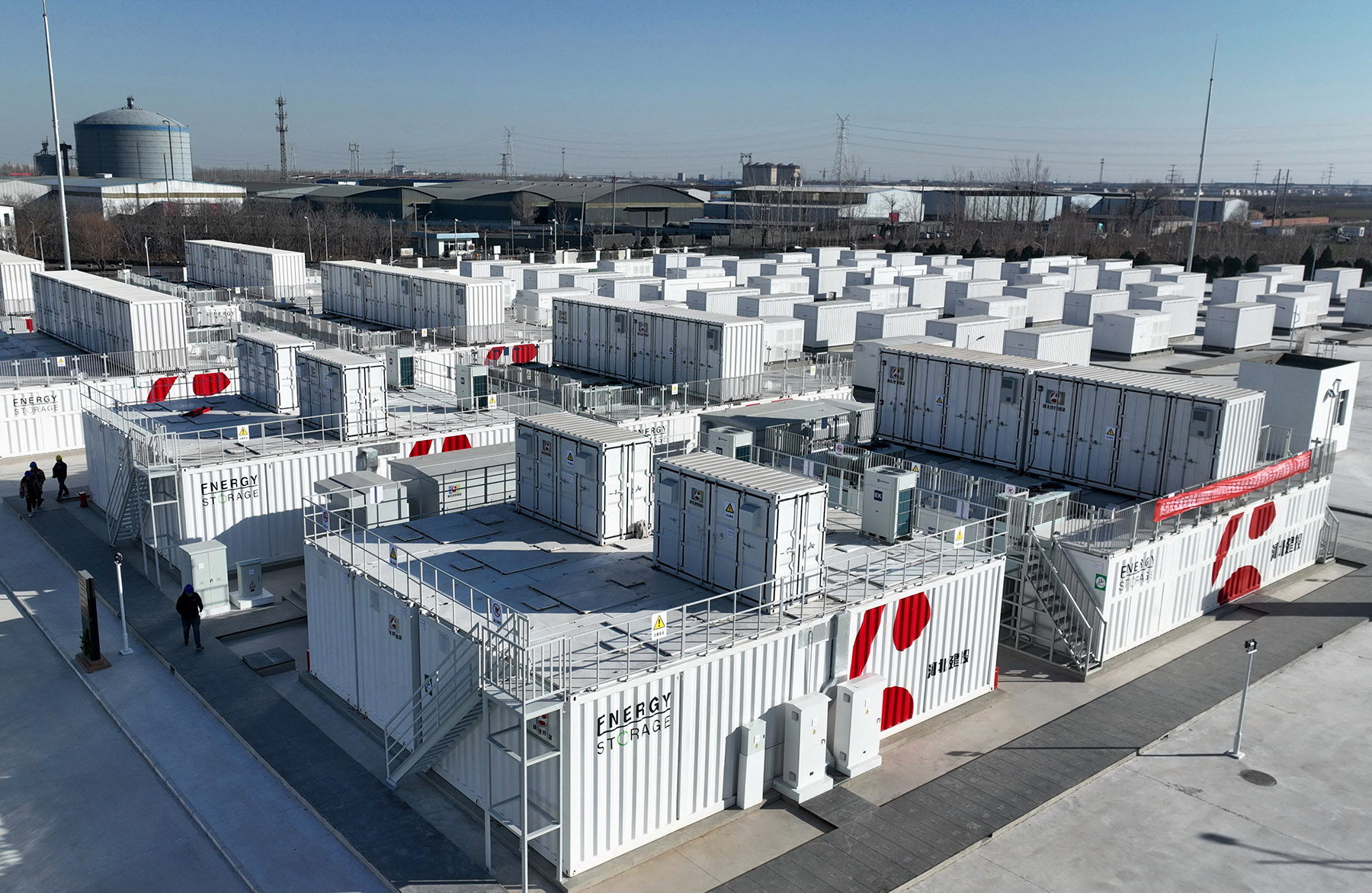Unprecedented innovation speeds up country's decarbonization goals

Leveraging its dominant position in electric vehicles, lithium batteries and solar panel manufacturing, China is now strategically positioned to tap into new-type energy storage as a key driver of economic expansion and energy security, said industry experts and company executives.
New-type energy storage, such as electrochemical energy storage and hydrogen storage, is poised to drive China's broader energy system transformation, alongside economic benefits, powering the nation's economic engine and ushering in an era of unprecedented energy independence and sustainability, they said.
The year 2024 witnessed an unprecedented surge in China's new energy storage sector, a dynamic expansion that redefines the nation's power grid and accelerates its ambitious carbon neutrality goals.
READ MORE: China to become a global energy storage powerhouse
According to the "Energy Storage Industry Research White Paper 2025" released during the recently concluded 13th Energy Storage International Conference and Expo held in Beijing, the new-type energy storage sector has sustained high-speed growth throughout the 14th Five-Year Plan (2021-25) period.
Looking ahead to 2025, the report anticipates newly installed new energy storage projects in China would exceed 30 gigawatts, further solidifying the nation's global leadership in the sector.
Crucially, the white paper highlighted a transformative shift in the sector's development model, predicting that new energy storage would transition from pilot demonstrations to large-scale commercial applications, ushering in a golden era of rapid expansion driven by market forces.
Newly commissioned new energy storage projects in 2024 reached an impressive scale of 43.7 GW, representing a year-on-year growth rate of 103 percent and accounting for 59 percent of global market share, demonstrating China's dominant position in the global energy storage landscape.
Notably, annual newly commissioned installed capacity surpassed the cumulative installed capacity of all previous years for the third consecutive year, signifying a paradigm shift in China's energy storage portfolio.
With the performance of lithium batteries significantly improving over the past few years and the iteration of multiple technology routes accelerating, the energy storage industry has achieved scaled development, said Chen Haisheng, chairman of China Energy Storage Alliance.
The number of newly added enterprises has reached a record high, while industry capacity keeps increasing and prices also decreasing, he said.
Chen emphasized that China's primary energy storage technologies are now largely on par with the most advanced global levels, with lithium batteries, compressed air energy storage and flow batteries achieving international leadership positions.
According to the alliance, China's installed capacity of new-type energy storage exceeded that of pumped storage for the first time at the end of 2024, while new-type energy storage has also been highlighted in many regional industrial plans, and its value target for 2025 has exceeded 3 trillion yuan ($415.6 billion).
The National Energy Administration said newly installed capacity of new-type energy storage experienced explosive growth last year surpassing 70 million kilowatts and is poised to become a cornerstone of the global energy transition.
The cumulative operational capacity across China rose 130 percent year-on-year, with the average energy storage duration extended to 2.3 hours, up 0.2 hours from the 2023 figure, enhancing grid stability and renewable energy integration, it said.

The momentum from 2024 surged into the new year, with regions across China accelerating the development of new energy storage projects. Construction sites buzzed with activity as provinces vied to expand their storage capacities, recognizing the strategic importance of this burgeoning sector.
In East China's Jiangsu province, an innovative gravity-based energy storage system showcases a novel approach. A 35-storey steel structure houses around 1,000 25-metric-ton gravity blocks, which are lifted using surplus renewable energy to store potential energy and then carefully lowered during periods of peak demand, converting gravitational potential back into electricity.
The project is capable of generating 100,000 kilowatt-hours of electricity within just a four-hour discharge period.
In addition to gravitational energy storage, Chinese engineers are also exploring a multitude of innovative energy storage solutions and constructing many large projects.
In Changzhou, Jiangsu province, air compressed in salt caverns 1,000 meters underground is used for energy storage. The heat generated is transferred to thermal oil and then the electricity is regenerated on demand.
The world's largest single-unit magnetic levitation flywheel energy storage project was also connected to the grid and began operations in January in Penglai, Shandong province. During energy storage, external electrical energy propels flywheel rotors to spin faster, thereby storing energy kinetically.
Recognizing the strategic importance of new energy storage in achieving national energy goals, multiple government departments have been collaboratively promoting the sector's healthy and orderly development.
According to an action plan jointly issued by the Ministry of Industry and Information Technology and seven other government departments, the new-type energy storage manufacturing sector is expected to demonstrate international competitive advantages across the entire manufacturing chain by 2027, with a greater number of leading enterprises.
China will also launch measures to speed up the upgrading of mature technologies such as lithium batteries and support disruptive technological innovations, it said.
Amid the backdrop, foreign investors are eyeing China's burgeoning energy storage economy. US automaker Tesla's Shanghai energy storage Megafactory, the first of its kind that Tesla has built outside the United States, commenced trial production of its Megapack batteries at the end of last year and exported its first batch of Megapack energy-storage batteries in March.
Megapack is an electrochemical energy storage device that uses lithium batteries, a dominant technical route in the new-type energy storage industry.
Tesla Vice-President Tao Lin said that China offers a complete industrial chain, huge market potential and a production and business environment crucial for enterprise growth.
As the industry's scale surpassed the 75 million-kW threshold, research and development efforts entered a phase of accelerated iteration driving continuous improvement and diversification, said Lin Boqiang, head of the China Institute for Studies in Energy Policy at Xiamen University.
Technological innovation in energy storage is also advancing at an equally rapid pace and this dynamic innovation ecosystem is crucial for sustaining the industry's rapid growth and ensuring its long-term competitiveness, he said.
Bian Guangqi, deputy director-general of the NEA's energy saving and technology equipment department, said the government will continuously encourage the diversified development of new energy storage technologies.
Furthermore, Bian highlighted the ongoing efforts to "accelerate the improvement of the new energy storage standard system and strive to promote innovation in the new energy storage sector".
Bian said that as China's new energy storage industry is developing rapidly, installed capacity of new energy storage nationwide as of end-February had exceeded 75 million kW.
In 2024, the equivalent utilization hours of new energy storage stood at approximately 1,000 hours, doubling that of 2023, effectively supporting the construction of new power systems, he said.
With competition rising in China's energy storage market, Chinese companies are accelerating their expansion into international markets, with a particular focus on emerging economies, said Sun Chuanwang, a professor at the China Center for Energy Economics Research at Xiamen University.
New energy power equipment maker Sungrow Power Supply signed three landmark energy storage contracts last year with Saudi Arabia's Algihaz Holding, becoming the world's largest grid-side storage order. Each project will have a capacity of 2.6 gigawatt-hours, totaling 7.8 GWh.
ALSO READ: Nation charts development path for VPPs to secure power supply
In addition, with technological advances, Chinese companies — including Huawei and Envision Group — have also secured major energy storage contracts around the world.
While installed capacity is rapidly increasing, the energy storage sector is also facing a series of challenges.
Regarding the current issue of the "price war" led by intense internal competition, Tian Qingjun, senior vice-president of Envision Group, said the price war not only affects the profit margins of companies, but also hampers the sustainable development of the energy storage sector.
Tian called for the industry to avoid irrational competition that harms sustainable development.
Bian said the administration will further promote the orderly development of new energy storage technology, while vigorously supporting technological innovation, continuing to encourage the diversified development of new energy storage technologies and accelerating the improvement of the new energy storage standard systems.
zhengxin@chinadaily.com.cn


